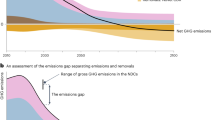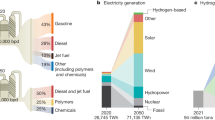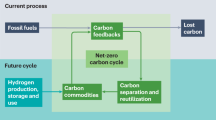Abstract
Cities offer unique strategies to reduce fossil fuel use through the exchange of energy and materials across homes, businesses, infrastructure and industries co-located in urban areas. However, the large-scale impact of such strategies has not been quantified. Using new models and data sets representing 637 Chinese cities, we find that such cross-sectoral strategies—enabled by compact urban design and circular economy policies—contribute an additional 15%–36% to national CO2 mitigation, compared to conventional single-sector strategies. As a co-benefit, ∼25,500 to ∼57,500 deaths annually are avoided from air pollution reduction. The benefits are highly variable across cities, ranging from <1%–37% for CO2 emission reduction and <1%–47% for avoided premature deaths. These results, using multi-scale, multi-sector physical systems modelling, identify cities with high carbon and health co-benefit potential and show that urban–industrial symbiosis is a significant carbon mitigation strategy, achievable with a combination of existing and advanced technologies in diverse city types.
This is a preview of subscription content, access via your institution
Access options
Access Nature and 54 other Nature Portfolio journals
Get Nature+, our best-value online-access subscription
$29.99 / 30 days
cancel any time
Subscribe to this journal
Receive 12 print issues and online access
$209.00 per year
only $17.42 per issue
Buy this article
- Purchase on Springer Link
- Instant access to full article PDF
Prices may be subject to local taxes which are calculated during checkout




Similar content being viewed by others
References
Ramaswami, A., Russell, A. G., Culligan, P. J., Sharma, K. R. & Kumar, E. Meta-principles for developing smart, sustainable, and healthy cities. Science 352, 940–943 (2016).
Lim, S. S. et al. A comparative risk assessment of burden of disease and injury attributable to 67 risk factors and risk factor clusters in 21 regions, 1990–2010: a systematic analysis for the Global Burden of Disease Study 2010. Lancet 380, 2224–2260 (2013).
Chavez, A. & Ramaswami, A. Articulating a trans-boundary infrastructure supply chain greenhouse gas emission footprint for cities: mathematical relationships and policy relevance. Energy Policy 54, 376–384 (2013).
Hillman, T. & Ramaswami, A. Greenhouse gas emission footprints and energy use benchmarks for eight US cities. Environ. Sci. Technol. 44, 1902–1910 (2010).
Kennedy, C. et al. Greenhouse gas emissions from global cities. Environ. Sci. Technol. 43, 7297–7302 (2009).
Seto, K. C. et al. in Climate Change 2014: Mitigation of Climate Change (eds Edenhofer, O. et al.) 923–1000 (IPCC, Cambridge Univ. Press, 2014).
Creutzig, F. et al. Urban infrastructure choices structure climate solutions. Nat. Clim. Change 6, 1054–1056 (2016).
World Energy Model Documentation (IEA, 2015).
Kennedy, C. A., Ibrahim, N. & Hoornweg, D. Low-carbon infrastructure strategies for cities. Nat. Clim. Change 4, 343–346 (2014).
Ramaswami, A. et al. Quantifying carbon mitigation wedges in US cities: near-term strategy analysis and critical review. Environ. Sci. Technol. 46, 3629–3642 (2012).
Chertow, M. R. ‘Uncovering’ industrial symbiosis. J. Ind. Ecol. 11, 11–30 (2007).
Berkel, R. V., Fujita, T., Hashimoto, S. & Fujii, M. Quantitative assessment of urban and industrial symbiosis in Kawasaki, Japan. Environ. Sci. Technol. 43, 1271–1281 (2009).
Lund, H. et al. 4th Generation District Heating (4GDH): integrating smart thermal grids into future sustainable energy systems. Energy 68, 1–11 (2014).
Li, Y., Xia, J., Fang, H., Su, Y. & Jiang, Y. Case study on industrial surplus heat of steel plants for district heating in Northern China. Energy 102, 397–405 (2016).
UNEP District Energy in Cities: Unlocking the Potential of Energy Efficiency and Renewable Energy (United Nations Environment Programme, 2015).
Brückner, S. et al. Industrial waste heat recovery technologies: an economic analysis of heat transformation technologies. Appl. Energy 151, 157–167 (2015).
Zhu, J. & Chertow, M. R. Greening industrial production through waste recovery: ‘comprehensive utilization of resources’ in China. Environ. Sci. Technol. 50, 2175–2182 (2016).
Leung, P. W. & Wong, H. Final Report on Durability and Strength Development of Ground Granulated Blast Furnace Slag Concrete (Geotechnical Engineering Office, Civil Engineering and Development Department, The Government of Hong Kong, 2010).
Nicoll, R. & Wei, G. Forging a Future in Green Steelmaking (CSIRO, 2015); http://www.csiro.au/en/News/News-releases/2015/Dry-slag-granulation
Implementation Plan for Reutilizing Waste Heat in District Heating System (NRDC, 2015).
Circular Economy Development Strategy and Immediate Plan of Action. http://www.gov.cn/zwgk/2013-02/05/content_2327562.htm (State Council of the PRC, 2013).
West, J. J. et al. Co-benefits of mitigating global greenhouse gas emissions for future air quality and human health. Nat. Clim. Change 3, 885–889 (2013).
Amann, M. et al. Cost-effective control of air quality and greenhouse gases in Europe: modeling and policy applications. Environ. Model. Softw. 26, 1489–1501 (2011).
Chen, D. S., Cheng, S. Y., Liu, L., Chen, T. & Guo, X. R. An integrated MM5–CMAQ modeling approach for assessing trans-boundary PM10 contribution to the host city of 2008 Olympic summer games—Beijing, China. Atmos. Environ. 41, 1237–1250 (2007).
City-Level Decoupling: Urban Resource Flows and the Governance of Infrastructure Transitions (United Nations Environment Programme, 2013).
National Bureau of Statistics Chinese Statistics Yearbook (China Statistics Press, 2014).
Woetzel, J. et al. Preparing for China’s urban billion. McKinsey Glob. Inst. 1–540 (2009).
Zhang, Y.-L. & Cao, F. Fine particulate matter (PM2.5) in China at a city level. Sci. Rep. 5, 14884 (2015).
Air Quality Guidelines: Global Update 2005: Particulate Matter, Ozone, Nitrogen Dioxide, and Sulfur Dioxide (World Health Organization, 2006).
GBD MAPS Working Group Burden of Disease Attributable to Coal-burning and Other Major Sources of Air Pollution in China (Health Effects Institute, 2016).
Zhang, J. Why the US and China Should Focus on Air Pollution to Tackle Climate Change AsiaSociety (6 March 2014); http://asiasociety.org/blog/asia/why-us-and-china-should-focus-air-pollution-tackle-climate-change
Connolly, D. et al. Heat roadmap Europe: combining district heating with heat savings to decarbonise the EU energy system. Energy Policy 65, 475–489 (2014).
Fridley, D., Levine, M. D., Lu, H. & Fino-Chen, C. Key China Energy Statistics 2014 (Lawrence Berkeley National Laboratory, 2014).
Zhang, L., Li, H. & Gudmundsson, O. Comparison of district heating systems used in China and Denmark. Euroheat and Power (English Edition) 10, 12–19 (2013).
Liu, J. et al. Air pollutant emissions from Chinese households: a major and underappreciated ambient pollution source. Proc. Natl Acad. Sci. USA 113, 7756–7761 (2016).
Johnson, I., Choate, W. T. & Davidson, A. Waste Heat Recovery. Technology and Opportunities in US Industry (BCS, Inc., MD, 2008).
Tong, K. et al. Energy cascading algorithms to estimate the potential for industrial waste heat reutilization in urban district energy systems: method development in two Chinese provinces. Environ. Res. Lett. (in the press).
Ling, W., Pei, T. & Yan, Y. International Workshop on Sustainable Development and Concrete Technology, Organized by China Building Materials Academy, PRC 309–317 (Center for Transportation Research and Education, Iowa State University, 2004).
Shen, W., Zhou, M., Ma, W., Hu, J. & Cai, Z. Investigation on the application of steel slag–fly ash–phosphogypsum solidified material as road base material. J. Hazardous Mater. 164, 99–104 (2009).
Gates, B. Have You Hugged a Concrete Pillar Today? GatesNotes (12 June 2014); https://www.gatesnotes.com/Books/Making-the-Modern-World
Institute for Industrial Productivity. CN-4:Industrial Energy Performance Standards. Industrial Efficiency Policy Database:http://iepd.iipnetwork.org/policy/industrial-energy-performance-standards (accessed 2016).
Ramaswami, A., Jiang, D., Tong, K. & Zhao, J. Impact of the economic structure of cities on urban scaling factors: implications for urban material and energy flows in China. J. Ind. Ecol. http://dx.doi.org/10.1111/jiec.12563 (2017).
Burnett, R. T. et al. An integrated risk function for estimating the global burden of disease attributable to ambient fine particulate matter exposure. Environ. Health Perspect. 122, 397–403 (2014).
Olivier, J. G. & Janssens-Maenhout, G. Trends in Global CO2 Emissions: 2015 Report (PBL Netherlands Environmental Assessment Agency, 2015).
Fu, X. et al. Emission inventory of primary pollutants and chemical speciation in 2010 for the Yangtze River Delta region, China. Atmos. Environ. 70, 39–50 (2013).
Schleussner, C.-F. et al. Science and policy characteristics of the Paris Agreement temperature goal. Nat. Clim. Change 6, 827–835 (2016).
China 2050 High Renewable Energy Penetration Scenario and Roadmap Study (Energy Foundation China, 2015).
The State Council of the People’s Republic of China Air Pollution Prevention and Control Action Plan (The State Council of the People’s Republic of China, 2013).
Lu, H. Capturing the Invisible Resource: Analysis of Waste Heat Potential in Chinese Industry and Policy Options for Waste Heat to Power Generation (Lawrence Berkeley National Laboratory (LBNL), 2015).
China Industrial Enterprise Database (National Bureau of Statistics, accessed 31 March 2016); http://www.allmyinfo.com/eng/services/index1-1.asp
China Census 2010 (National Bureau of Statistics, 2010).
Department of Urban & Social Economic China City Statistical Yearbook (China Statistics Press, 2011–2012).
Annual Development Report of China’s Power Industry (CEC, 2015).
Annual Development Report of China’s Power Industry (CEC, 2011).
China Steel Development Research Institute China Steel Yearbook 2015 (China Metallurgical Industry Press, 2015).
China Iron and Steel Industry Association China Steel Yearbook 2011 (China Metallurgical Industry Press, 2011).
Zhao, Y. et al. Primary air pollutant emissions of coal-fired power plants in China: current status and future prediction. Atmos. Environ. 42, 8442–8452 (2008).
Lei, Y., Zhang, Q., Nielsen, C. & He, K. An inventory of primary air pollutants and CO2 emissions from cement production in China, 1990–2020. Atmos. Environ. 45, 147–154 (2011).
Wang, S. et al. Emission trends and mitigation options for air pollutants in East Asia. Atmos. Chem. Phys. 14, 6571–6603 (2014).
MEIC Multi-Resolution Emission Inventory for China (accessed 31 March 2016, 2016); http://www.meicmodel.org
Ministry of Housing and Urban-Rural Development of China China Urban Construction Statistical Yearbook (China Planning Press, 2011).
China Energy Statistical Yearbook (National Bureau of Statistics, 2011).
Zhou, N. Energy for 500 Million Homes: Drivers and Outlook for Residential Energy Consumption in China (Lawrence Berkeley National Laboratory, 2010).
Zhou, N. & Lin, J. The reality and future scenarios of commercial building energy consumption in China. Energy Build. 40, 2121–2127 (2008).
Ramaswami, A., Jiang, D., Tong, K. & Zhao, J. Impact of the economic structure of cities on urban scaling factors: implications for urban material and energy flows in China. J. Ind. Ecol. http://dx.doi.org/10.1111/jiec.12563 (2017).
Bentz, D. P., Ferraris, C. F. & Snyder, K. A. Best Practices Guide for High-Volume Fly Ash Concretes: Assuring Properties and Performance Technical Note 1812 (US Department of Commerce, National Institute of Standards and Technology, 2013).
Thomas, M. Optimizing the Use of Fly Ash in Concrete 5420 (Portland Cement Association Skokie, 2007).
Gómez, D. R. & Watterson, J. D. Chapter 2: Stationary Combustion (IGES, 2006).
Zhao, Y., Zhang, J. & Nielsen, C. P. The effects of energy paths and emission controls and standards on future trends in China’s emissions of primary air pollutants. Atmos. Chem. Phys. 14, 8849–8868 (2014).
Lei, Y., Zhang, Q., He, K. B. & Streets, D. G. Primary anthropogenic aerosol emission trends for China, 1990–2005. Atmos. Chem. Phys. 11, 931–954 (2011).
Huang, Y. et al. Quantification of global primary emissions of PM2.5, PM10, and TSP from combustion and industrial process sources. Environ. Sci. Technol. 48, 13834–13843 (2014).
Cimorelli, A. J. et al. AERMOD: a dispersion model for industrial source applications. Part I: General model formulation and boundary layer characterization. J. Appl. Meteorol. 44, 682–693 (2005).
Zhang, Y.-L. & Cao, F. Fine particulate matter (PM2.5) in China at a city level. Sci. Rep. 5, 14884 (2015).
Ramaswami, A. et al. A Social-ecological-infrastructural systems framework for interdisciplinary study of sustainable city systems. J. Ind. Ecol. 16, 801–813 (2012).
Keirstead, J., Jennings, M. & Sivakumar, A. A review of urban energy system models: approaches, challenges and opportunities. Renew. Sustain. Energy Rev. 16, 3847–3866 (2012).
Acknowledgements
This work was supported by a NSF Partnerships in International Research and Education grant (PIRE-1243535), Tsinghua University Initiative Scientific Research Program (No. 20121088096), and National Science Foundation of China (21625701). We thank M. Ahern and P. Bourne of Evergreen Energy (Saint Paul, Minnesota) for reviewing the district energy scenarios. We thank H. Shen for reviewing the results of air pollution modelling. We also appreciate G. Chan’s comments on this paper.
Author information
Authors and Affiliations
Contributions
A.R., L.S., M.C., A.F., K.T., Y.L. and D.J. designed the urban energy and material-exchange interventions; R.M.L., A.S.N. and A.G.R. implemented the air pollution and health risk models. A.R., K.T., Y.W., S.W., L.S. and Y.L. developed the city infrastructure database; L.S. and Y.H. developed the China industry waste heat case studies. A.F. and K.T. implemented scenario modelling. A.R. led the writing and data checks, and K.T. led data coordination across nations and graphics.
Corresponding author
Ethics declarations
Competing interests
The authors declare no competing financial interests.
Supplementary information
Supplementary Information
Supplementary Information (PDF 1220 kb)
Rights and permissions
About this article
Cite this article
Ramaswami, A., Tong, K., Fang, A. et al. Urban cross-sector actions for carbon mitigation with local health co-benefits in China. Nature Clim Change 7, 736–742 (2017). https://doi.org/10.1038/nclimate3373
Received:
Accepted:
Published:
Issue Date:
DOI: https://doi.org/10.1038/nclimate3373
This article is cited by
-
Co-production of steel and chemicals to mitigate hard-to-abate carbon emissions
Nature Chemical Engineering (2024)
-
Sustainable development pathways for energies in Yangtze River Delta urban agglomeration
Scientific Reports (2023)
-
Cities and regions tackle climate change mitigation but often focus on less effective solutions
Communications Earth & Environment (2023)
-
An integrated framework for industrial symbiosis performance evaluation in an energy-intensive industrial park in China
Environmental Science and Pollution Research (2023)
-
City- and county-level spatio-temporal energy consumption and efficiency datasets for China from 1997 to 2017
Scientific Data (2022)



